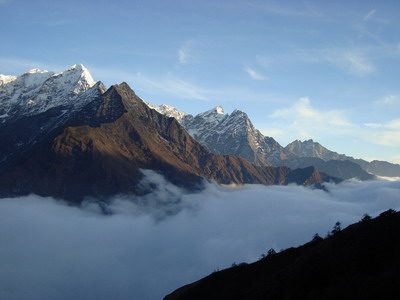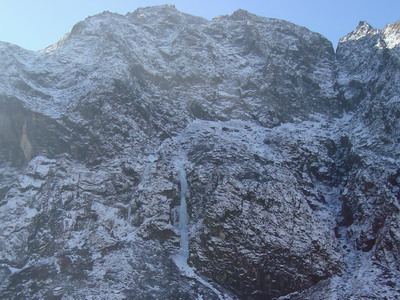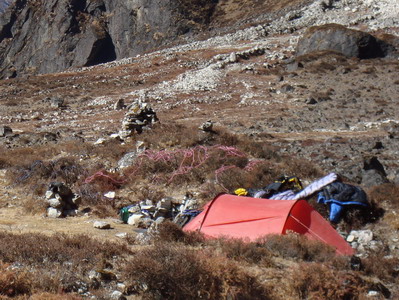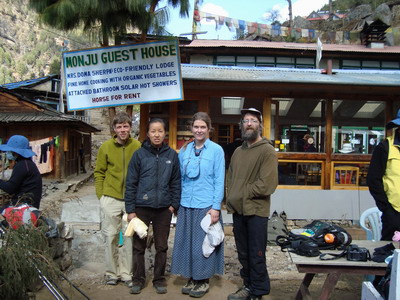 Dudh Koshi Valley, the main trekking route from Lukla to Namche Bazar.
Dudh Koshi Valley, the main trekking route from Lukla to Namche Bazar.
Shyangboche -maa malaai boknos
(Please carry me to Syangboche)
Nepali Phrasebook
 Dudh Koshi Valley, the main trekking route from Lukla to Namche Bazar.
Dudh Koshi Valley, the main trekking route from Lukla to Namche Bazar.
|
The most remote area described here, Kusum Kunguru basecamp, can be reached in a day from the main trekking route; most other climbs are within a few hours from a nearby village. Many climbs are doable in a day trip out of a lodge; however, camping and climbing in a beautiful place such as Kusum Kunguru or Minmo Khola is especially enjoyable.
 A beautiful ice flow in the Minmo Khola valley decorated with some fresh snow, 31 December 2008.
A beautiful ice flow in the Minmo Khola valley decorated with some fresh snow, 31 December 2008.
|
January is perhaps the best time for ice climbing in the region – climbs such as Losar were building before our eyes from December into January; February may be good as well, although increased sunshine will take toll on some climbs. Ice flows located at higher altitudes are formed earlier and might be climbable as early as late November. Both 2008-2009 and 2009-2010 seasons were low in snow, therefore we believe that the climbs we have found in good condition will be in every year, and many more routes may form if there’s more precipitation during the fall.
Above 4000m we typically found very brittle ice unless water flowed over it which happened quite often. Frozen ropes is a major concern, and bringing dry ropes in good condition is advisable.
The winter weather in Khumbu is dry and stable: in 2009 there was no precipitation for the whole month of January; in 2010 a little bit of snow fell at the end of the month. However, according to the locals, heavy snowfalls do sometimes occur even during this dry season.
Temperatures vary widely depending on the altitude and time of the day. At 4000m the night temperature is somewhere around -10 C and the daytime temperature on north-facing slopes (i.e. on the ice climbs) is probably not much higher than that. On south-facing slopes it may be warm enough in the sun to go around without a shirt.
On the south-facing slopes snow melts fast after a snowfall, and they typically stay snow-free until at least 5000m. North-facing slopes will typically have some snow. Deep snow, as to make going difficult, let alone pose an avalanche danger, was never encountered below 5000m during the two seasons.
 Drying ropes at the Kusum Kunguru camp.
Drying ropes at the Kusum Kunguru camp.
|
In general, an ice climber has the same status as a trekker and is only required to pay the park entrance fee of 1000 Rs (100 Rs ~ 1 Euro). Entry permits can be purchased either at the tourist office in Kathmandu or at the park entrance in Monjo. Trekkers are also required to carry a Trekker’s Registration Card (TIMS). Those can be obtained for free at the Kathmandu tourist office. We have seen people showing up at the Monjo park entrance without TIMS and they weren’t turned away (it is advisable, however, to bring some passport-sized photographs and at least a photocopy of your passport).
Camping supplies and fuel are amply available in Kathmandu (and camping gas canisters are allowed on flights to Lukla). Basic supplies (noodle soup, sugar, oatmeal, tsampa, cheese, chocolate, cookies etc.) are also available in Namche (cheaper at the bazar on Friday-Saturday) and in villages along the way. Fuel (Primus gas canisters) is also available in Namche.
I believe that a party used to self-sufficient mountain travel should be able, after proper acclimatization, to go on a camping/climbing trip without hiring porters. However, we did hire porters to carry camping gear and food to the Minmo Khola valley. The porter cost per 20 kg load per day is about $10. To the Kusum Kunguru basecamp we went without porters; however, initially we went there with a minimal amount of food and fuel and later returned to resupply. Also, three of us carried climbing gear for two climbers only: we would take turns with two people climbing and the third resting, which worked out very well.

 back to the main page
back to the main page